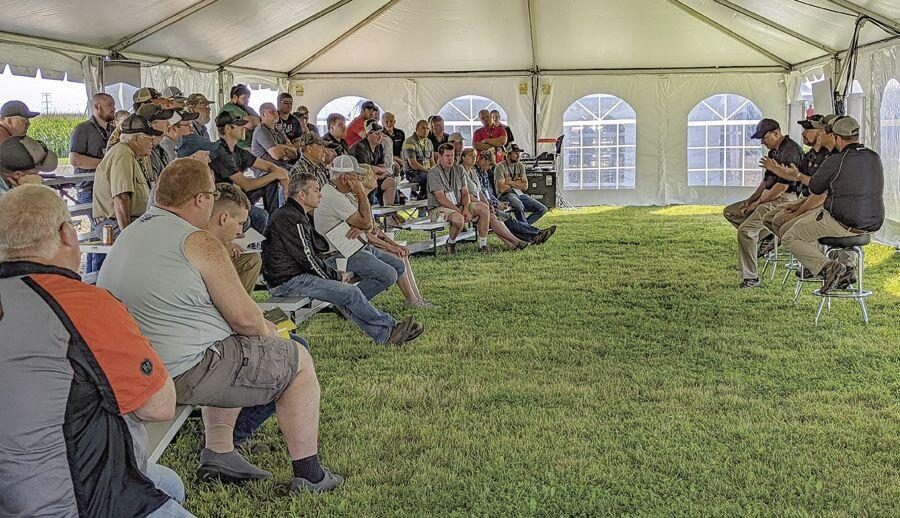By: Chad Smith
Farmers who don’t properly care for their soil either struggle to stay afloat or don’t stay in business. That was just one of many topics during a recent Beck’s Hybrids Minnesota Field Show on the east side of Gibbon.
Cover crops are an increasingly popular option for taking care of the soil.
“It’s very much so,” says Ryan Moore, small seed product manager for Beck’s. “When you look back at survey data, we were around five million acres planted to cover crops about ten years ago. Now, we’re somewhere between 20-25 million acres today.”
The biggest factor driving the interest is farmers wanting to improve their soil. Moore says they read articles regularly that tout the benefits of the practice and that interest is helped out by government programs that incentivize cover crop practices for growers.
“It piques their interest because it all boils down to their bottom line at the end of the day,” Moore said. “The practice especially helps from a nitrogen standpoint. If they can get their cover crops scavenging some nutrients, they can cut back a little on their nitrogen programs. That’s especially good today when nitrogen is three times more expensive than a year ago.”
Government is not the only group backing more cover crops. Beck’s runs a program in Indiana designed to help farmers transition into cover crops. They’re working with the Indiana Soybean Alliance on a five-year program and to “step them into a cover crop program.”
“Maybe during the first year, it’s oats and radishes and winterkills,” Moore said. “We encourage growers to start out the planting ahead of soybeans, which are pretty forgiving. The following year, we might do something that overwinters, like rye or rapeseed. The program's biggest goal is making sure the farmers have some success.
“I talk to a lot of growers who tried cover crops, had a bad experience, and they kick it to the side of the road,” he added. “They tell themselves they aren’t going to do that again, and we don’t want that to happen.”
During his presentations in the Cover Crop Tent at the show, Moore told farmers their overall goal should be to get into a “no-till situation” when establishing a program. The ideal situation is to plant a cover crop in the fall and then come into the spring to burn it down before planting begins.
“The advantage to working no-till into a cover crop program is it expedites the process to promote soil health,” Moore says. “You’ll get more earthworms, biological activity in your soil, and more things feeding on those roots. You create a soil structure far superior to anything done by that first six inches of tillage."
Cover crop programs are especially important in areas where sediment runoff is a big problem. With its rolling topography, Iowa is a good example of a place that could lose a lot of soil to erosion if farmers aren’t careful.
“No-till and cover crops will help that soil stay there,” Moore said.
When trying to establish a cover crop program, it’s important to pick the right kind of crop. Nathan Firle, western regional agronomy manager with Beck’s, says he’s had good cover crop experiences when he plants them after a canning crop or small grain.
“If I have a long enough growing season left to establish that cover crop, get it growing and get some root mass into the soil, then I get the full benefit from them,” Firle said.
However, that growing season can often be a challenge in the northern climate. Sometimes farmers will put a cover crop in the ground right ahead of a frost and then the ground is frozen all winter. What happens if spring is late?
“We make a termination pass or run a field cultivator out there, which means that investment in the cover crop didn’t yield anything,” Firle said.
“But cover crops do have a fit,” he added. “I know farmers who are utilizing them in strip-till operations. They’re keeping something growing within that row, but they’re managing the strip of where they’re planting and where that crop is growing. That seems to be a strategy working well up here in the North because it eliminates the need for a long window to plant those cover crops.”
He said cover crops are great because something is always growing in the soil.
“If you have something constantly growing, that cycle keeps going,” Firle added. “Constant growth is good for the atmosphere – pulling CO2 out of the air. We’re also helping soil biology by not letting it go into a ‘fallow syndrome’ because we’ve given it food, energy, and oxygen, so cover crops are a good idea.
“It’s all about properly managing the timing of when we establish those crops,” Firle concluded.





Post a comment
Report Abusive Comment